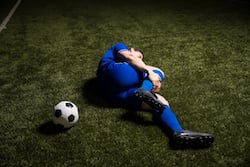 With the World Cup well underway and Team USA gearing up to play the Netherlands this coming weekend, it's an opportune moment to examine the findings of a published study in The Journal of Orthopaedic Surgery and Research on elite football (known as soccer here) players. Researchers conducted a retrospective analysis of treatments and recovery times of muscle injuries suffered by the players of an elite football team competing in the first/second German Bundesliga during a recent season.
With the World Cup well underway and Team USA gearing up to play the Netherlands this coming weekend, it's an opportune moment to examine the findings of a published study in The Journal of Orthopaedic Surgery and Research on elite football (known as soccer here) players. Researchers conducted a retrospective analysis of treatments and recovery times of muscle injuries suffered by the players of an elite football team competing in the first/second German Bundesliga during a recent season.
Football, also known as soccer here in the US, features elite athletes who can be sidelined by acute muscle injuries at any moment. The universal desire to return to play faster is common among elite athletes, and ESWT facilitates accelerated healing and return to activity.
In the study, scientists reviewed lay-off times obtained by treating elite football players for acute muscle injuries with a multimodal therapy regimen. This protocol featured almost daily treatment with radial Extracorporeal Shockwave Therapy and was further supported with complementary therapies. For a thorough exploration, read the study titled "Return to Play After Treating Acute Muscle Injuries in Elite Football Players with Radial Extracorporeal Wave Therapy."
Types of Muscle Injuries in Sports
Particularly among elite athletes, muscle injuries are a common occurrence. Classifying the type of muscle injury is a standard practice among medical professionals. Indirect muscle injuries include two types, functional and ultrastructural muscle disorders.
Indirect Muscle Injuries
- Type 1 indicates overexertion-related muscle disorder
- Type 1a: fatigue-induced muscle disorders/muscular tightening/hypertonicity
- Type 1b: delayed-onset muscle soreness
- Type 2 indicates neuromuscular muscle disorder
- Type 2a: spine-related neuromuscular disorders
- Type 2b: muscle-related neuromuscular disorders/muscle strain injury
When it comes to structural muscle injuries, there is a high incidence rate which may account for more than half of all sports injuries.
Structural Muscle Injuries
- Type 3 indicates partial muscle tears
- Type 3a: minor partial muscle tear (< 5 mm; intrafascicle/bundle-tear)
- Type 3b: moderate partial muscle tear (> 5 mm; interfascicle/bundletear
- Type 4 refers to a complete muscle tear or tendinous avulsion
Trauma from direct impact or external force results in direct muscle injuries.
Direct Muscle Injuries
- Contusion, aka bruising, can cause pain, swelling, and decreased range of motion
- Laceration resulting from trauma affecting fascia down to the muscle.
Methods of the Retrospective Study
Researchers performed a retrospective analysis of treatments and lay-off times of all muscle injuries suffered by the participants (players of an elite football team). Written informed consent was obtained from all study participants.
All athletes in the study were male, aged 18 -35 years old. Details collected included:
- Dates of injury
- Side of injury
- Player's position
- Whether an injured player was left-footed or right-footed
- Whether an injury impacted a player's support leg or kicking leg
The player diagnosis was based on clinical examination, functional testing, and comparison with the non-injured limb, and patient pain was assessed and recorded using VAS (Visual Analog Scale).
Multimodal Therapy Protocol for Acute Muscle Injuries
All injured players with acute muscle injuries were treated with a multimodal therapy customized to the patient's condition and included Radial Pressure WaveWave Therapy in 19 of the 20 cases. The additional multimodal treatments utilized in the study included cryotherapy, compression, manual therapy, resistance/weight-training, and an advanced physical therapy exercise program.
The decision to utilize rESWT protocols in the patient treatment plan was influenced by previous promising clinical experiences in a study and positive player information.
Results and Take-Aways of the Retrospective Study
In summary, 20 acute muscle injuries were diagnosed and treated in a recent football season. Among the professional footballers treated, here are the conditions diagnosed:
- 40% with Type 1a muscular tightness injuries
- 25% with Type 2b muscle strain injuries
- 20% with Type 3a partial muscle tear injuries
- 15% with contusions
Compared with previous studies' data, lay-off times were shortened by as much as 58%, and no adverse reactions were observed or reported.
In conclusion, the multimodal approach with ESWT proved to be a safe, favorable, and effective treatment protocol for 1a and 2b muscle injuries. Such treatment may also benefit elite football players by preventing more severe structural muscle injuries.
Help Patients Return to Play FASTER by Integrating ESWT into Your Plan of Care
Whether you treat elite athletes, armchair quarterbacks, or active seniors, everyone wants to get back in action quickly and eradicate nagging pain once and for all. Providing evidence-based, non-invasive treatment options, including shockwave, can be a real game-changer. Today patients seek regenerative therapies by name, and providing them with the treatment options they seek improves patient outcomes and accelerates practice growth.
Go beyond the limits of traditional protocols to broaden your treatment horizons, and explore the power of innovative regenerative technologies and products from CuraMedix.
We proudly represent STORZ Medical as the leading full-service U.S. distribution partner supporting the complete suite of STORZ Medical radial pressure wave, focused shockwave, and now "High Energy" Magnetotransduction (EMTT) devices.
Have questions? Contact us today, and we'll connect you with one of our shockwave experts.



